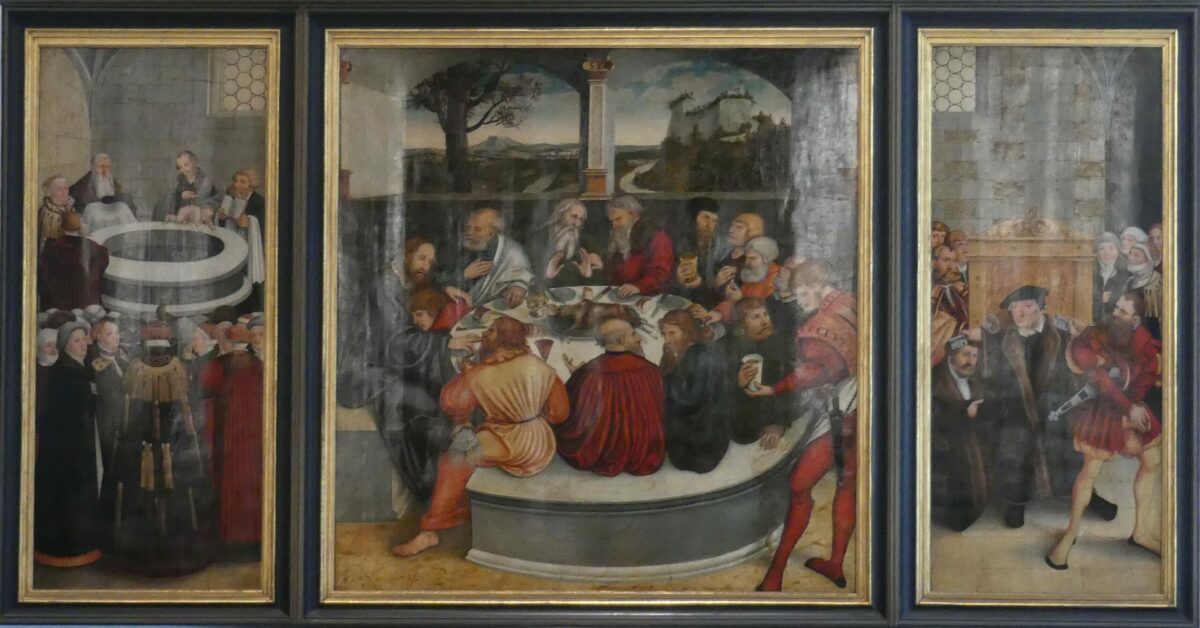The Lord’s Supper and the Communal Shape of the Christian Life
Last November the Rev. Dr. Peter H. Nafzger was the speaker for the annual Vern Gundermann Reformation Heritage Lecture sponsored by Concordia University – St. Paul, Minnesota. Much of what Dr. Nafzger said resonated with aspects of our research on the adult catechumenate and its role in congregational life. With his permission, I’m sharing some of the main points of his lecture and drawing connections with our research congregations.
Structured around Ricoeur’s three “worlds of the text,” in part I, The Defigured World (a renaming of Ricoeur’s “prefigured world”), Nafzger argued that the current “defiguring” of Christianity is its over-emphasis on the Christian life as one that is lived individually. Citing research on younger generations within the church, he concluded that a major cause for their absence within the church and abandonment of Christianity is that “young people are not experiencing community” in their local congregations.
In part II, “Toward a Configured World,” Nafzger used social science research to identify the problem or malady in the here and now of society, citing the “loneliness epidemic” in our country and the “social frailty index” to demonstrate the human need and desire for community. Yes, he notes, people find community outside the church, but it is self-selected, temporary, and tribalistic; thus, it is helpful today to highlight the communal nature of the Christian life, the “Configured World.”
Deep into part II, just as I began to question how this material could be considered a “Reformation Lecture,” Dr. Nafzger introduced part III, “The Refigured World,” finding the remedy or solution to the core problem in our society (and church) in one of Luther’s early writings on the Lord’s Supper—before the main controversaries of the sixteenth century, Transubstantiation and the Real Presence of Christ in this sacred meal—dominated the theological discussions. I would add that those controversies continue to shape the Lutheran focus on and interpretation of the Lord’s Supper. We have, to use the language of a Roman Catholic liturgical scholar, overemphasized this sacrament as individual reception of “sacred food” and thus lost any sense or meaning of the sacrament as a “holy meal” shared in community.[1]
In “The Blessed sacrament of the Holy and True Body of Christ, and Brotherhoods” (1519), Luther declared:
The significance or effect of this sacrament is fellowship of all the saints….
This fellowship consists in this, that all the spiritual possessions of Christ and his saints are shared with and become the common property of [the one] who receives this sacrament….
Then we may … say, “Though I am a sinner … nevertheless I will go to the sacrament to receive a sign from God that I have on my side Christ’s righteousness, life, and sufferings, with all holy angels and the blessed in heaven and all pious [people] on earth. If I die, I am not alone in death; if I suffer, they suffer with me … all my misfortune is shared with Christ and the saints because I have a sure sign of their love toward me” (Luther’s Works, vol. 35, pp. 50, 51, 54, emphasis added).
In a “Refigured World,” congregations would have a robust communal identity and practices—precisely what our research supports. Those who had participated in the congregation’s adult faith formation process expressed a deep appreciation for the sense of community and belonging they experienced within these parishes; one important commonality of the four research congregations is weekly celebration of Holy Communion. Dr. Nafzger’s lecture breaks open the possibility of correlation between the frequent offering of this sacrament with the formation of a community that “bears one another burdens,” living in love with one another. According to Luther, “It is Christ’s will, then, that we partake of it frequently, in order that we may remember him and exercise ourselves in this fellowship according to his example” (56, emphasis added).
This Holy Meal is an intimate union between Christ and all the saints, a joining together of Christ the Head with his Body, the church, a community that is, in Nafzger’s words, “chosen by God, eternal, and hospitable.”
[1] Mitchell, Cult and Controversy (New York: Pueblo, 1982).
+++++++++
To view Dr. Nafzger’s full lecture, click here.
For the Surgeon General’s report “Our Epidemic of Loneliness and Isolation,” click here.
For research on the social frailty index, click here.
Image from Wiki Commons: Reformation altarpiece depicting means of grace, center (The Lord’s Supper). Artists: Lucas Cranach the Elder; Lucas Cranach the Younger and workshop (1547); Marienkirche, Wittenberg, Germany; photo by Feldstein, 2017; https://commons.wikimedia.org/wiki/File:%22Reformationsaltar%22_in_der_Kirche_St._Marien_in_Wittenberg-Lutherstadt.jpg
